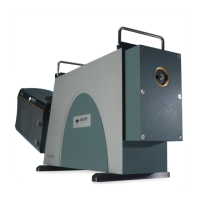54
Version 4.2 rev 06 Oct 2020
8.2 x 8.2 mm / 512 x 512 sensor
Lowest Noise Imaging EMCCD
Mechelle
4.11.1 eFFect oF aMbient teMpeRatuRe on tHe Relative eFFiciency coRRection
When the ambient temperature changes, the refractive index of the prisms will change which result in a shift of the
orders in the vertical direction, i.e. the light of a certain wavelength will fall on a different pixel on the sensor. Since there
is a small variation between the response of pixels, therefore the relative efciency correction will not be valid and the
corrected signal should look like that shown below:
Figure 26: Effect of the temperature change on relative efciency corrected signal
NOTE: If the ambient temperature is changed by ±3ºC, the Relative Efciency Correction will not be valid and the
corrected signal will look similar to the above, but the wavelength calibration will remain accurate.
4.11.2 Relative eFFiciency coRRection WitH sub-spectRuM
To carry out the relative efciency correction with sub-spectrum, the following procedure must be carried out:
1. Firstly, take a full spectrum as described previously.
2. Click the
button to select the wavelength range required and click update.
3. Close the wavelength selector window.
4. Click
and carry out the Relative Efciency Correction Procedure.
NOTES:
1. Do not take a scan between selecting the wavelength range and relative efciency procedure. If you do, the
button will not be active, i.e.
2. If the wavelength range is changed, the following message will be displayed:
The REC procedure must then be repeated. The software will also change the acquisition settings to Full Image for the
next acquisition only to prepare for Relative Efciency procedure. Just click the
button and carry out the procedure
again.
3. If the sub-spectrum set is between 400 - 975 nm, only a QTH Standard lamp is needed, so the deuterium
lamp is not necessary

